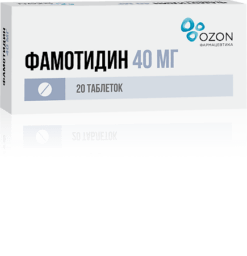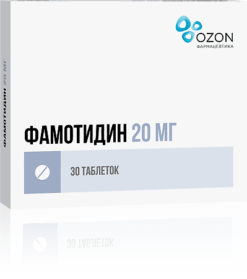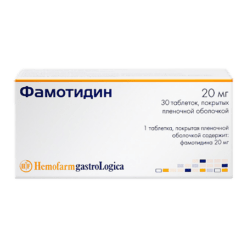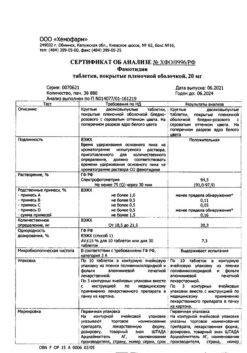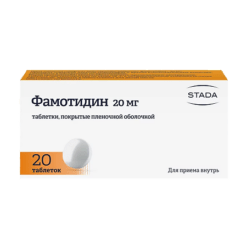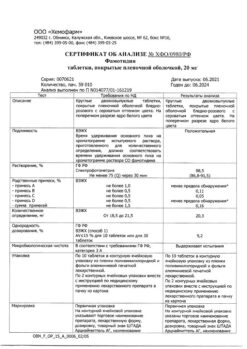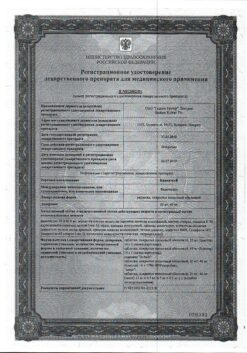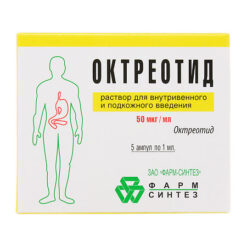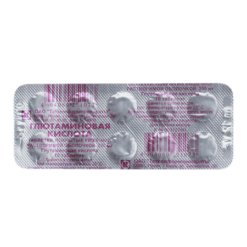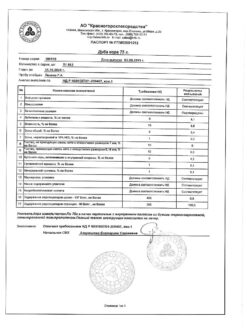No products in the cart.
Famotidine, 40 mg 30 pcs
€3.00
EAN: 4607143560451
SKU: 105297
Categories: Medicine, Stomach, intestines, liver, Ulcer and gastritis
Description
Gastroduodenitis, Heartburn, Sour belching, Gastric and duodenal ulcer, Subscapular pain, Reflux esophagitis, GastritisFamotidine is recommended for inpatients who are unable to take the drug orally. Parenteral administration of famotidine may be used until oral therapy becomes feasible.
– Duodenal ulcer disease;
– peptic ulcer without malignization (good clinical effect in response to famotidine administration does not allow to exclude the presence of ulcer malignization);
– gastroesophageal reflux disease;
– other conditions accompanied by hypersecretion of gastric juice (e.g., Zollinger-Ellison syndrome);
– prevention of Mendelson syndrome (aspiration of acidic gastric contents) during general anesthesia.
Indications
Indications
Famotidine is recommended for use in inpatients who are unable to take the drug orally. Parenteral famotidine may be used until oral therapy is possible.
– Peptic ulcer of the duodenum;
– gastric ulcer without malignancy (a good clinical effect in response to the prescription of famotidine does not exclude the presence of malignancy of the ulcer);
– gastroesophageal reflux disease;
– other conditions accompanied by hypersecretion of gastric juice (for example, Zollinger-Ellison syndrome);
– prevention of Mendelssohn’s syndrome (aspiration of acidic gastric contents) during general anesthesia.
Pharmacological effect
Pharmacological effect
Famotidine suppresses the release (secretion) of hydrochloric acid.
Special instructions
Special instructions
Before starting therapy, or, if this is not possible, before switching to oral treatment, it is necessary to exclude the presence of a malignant neoplasm of the stomach.
In case of renal and/or liver failure, famotidine should be used with caution at a reduced dose.
Since cross-allergy has been described with the use of histamine H2 receptor blockers, the use of famotidine in patients with a history of hypersensitivity to other histamine H2 receptor blockers requires caution.
Impact on the ability to drive vehicles. Wed and fur.:
Patients should be careful when performing work that requires rapid psychomotor reactions (including when driving vehicles and working with equipment), since dizziness and increased fatigue may occur during treatment.
Active ingredient
Active ingredient
Famotidine
Composition
Composition
1 film-coated tablet 40 mg contains:
Contraindications
Contraindications
– Hypersensitivity to famotidine or other components of the drug;
– pregnancy and breastfeeding;
– age up to 18 years.
With caution:
Hepatic and/or renal failure, liver cirrhosis with encephalopathy (history), immunodeficiency states.
History of allergy to other H2-histamine blockers (possible cross-hypersensitivity).
Side Effects
Side Effects
The incidence of side effects after using the drug is classified according to WHO recommendations: rare (≥1/10000 and <1/1000), very rare (<1/10000), frequency unknown (it is not possible to determine the frequency of occurrence from the available data).
From the gastrointestinal tract: rarely – diarrhea, constipation; very rarely – abdominal discomfort, nausea, vomiting, dry mouth, anorexia, various taste disorders.
From the liver and biliary tract: very rarely – cholestatic jaundice.
From the central nervous system: rarely – headache, very rarely – dizziness, convulsive epileptiform seizures.
From the mental side: very rarely – depression, hallucinations, agitation, anxiety, confusion, insomnia; drowsiness.
From the musculoskeletal system: very rarely – arthralgia, myalgia. muscle spasms.
From the blood and lymphatic system: very rarely – agranulocytosis, leukopenia, pancytopenia, thrombocytopenia.
From the skin and subcutaneous tissues: very rarely – acne, alopecia, dry skin, toxic epidermal necrolysis.
From the organ of hearing and vestibular apparatus: frequency unknown – tinnitus.
From the genital organs and mammary gland: very rarely – gynecomastia (if treatment is stopped, it is reversible), decreased libido, impotence.
From the immune system: very rarely – anaphylaxis, urticaria, skin rash, hyperemia of the sclera and skin, angioedema, swelling of the periorbital areas of the eyes, face.
From the cardiovascular system: very rarely – arrhythmia, atrioventricular block, palpitations.
From the respiratory system, chest and mediastinal organs: very rarely – bronchospasm.
General disorders and disorders at the injection site: very rarely – increased fatigue, asthenia, fever.
Laboratory and instrumental data: very rarely – increased activity of liver enzymes.
Interaction
Interaction
Compatible with 0.9% sodium chloride solution, 5% dextrose solution, 4.2% sodium bicarbonate solution.
Increases the absorption of amoxicillin and clavulanic acid.
Antacids and sucralfate slow the absorption of famotidine after oral administration.
Reduces the absorption of itraconazole and ketoconazole.
Bone marrow depressants increase the risk of developing neutropenia.
Overdose
Overdose
In patients with pathological hypersecretion syndrome, doses of up to 800 mg per day have been prescribed for periods of over one year, which has not been accompanied by the occurrence of serious adverse events.
Treatment: symptomatic and supportive therapy; monitoring the patient’s condition.
Storage conditions
Storage conditions
In a place protected from light, at a temperature not exceeding 25 ° C.
Keep out of the reach of children.
Shelf life
Shelf life
3 years.
Do not use the drug after the expiration date indicated on the package.
Manufacturer
Manufacturer
Hemofarm LLC, Russia
Additional information
| Shelf life | 3 years. Do not use the drug after the expiration date stated on the package. |
|---|---|
| Conditions of storage | In the dark place at a temperature not exceeding 25 °С. Store out of the reach of children. |
| Manufacturer | Chemopharm LLC, Russia |
| Medication form | pills |
| Brand | Chemopharm LLC |
Other forms…
Related products
Buy Famotidine, 40 mg 30 pcs with delivery to USA, UK, Europe and over 120 other countries.


